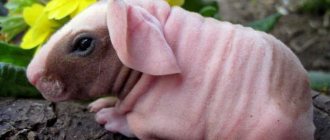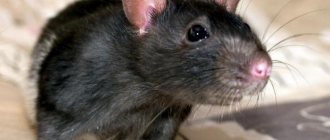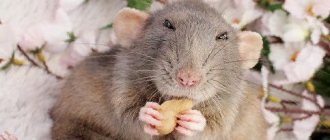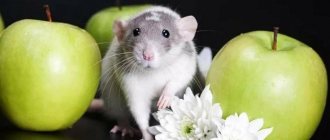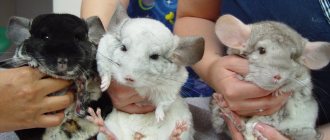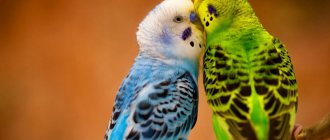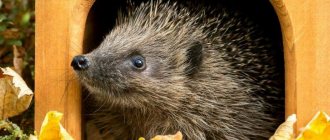Chinchillas are popular pets from the rodent family with an attractive appearance and funny character. They are easy to care for, clean and do not require constant attention. But there are still some rules for keeping pet chinchillas that a novice owner should familiarize himself with in advance.
In the article we will tell you how to keep a chinchilla at home, what conditions need to be created, what is the life expectancy of the rodent, character traits and behavior, choice of cage and its arrangement, diet, how to tame and walk your pet, is it possible to bathe, breeding, what diseases do you have? chinchillas, advantages and disadvantages of keeping them.
Chinchilla and its maintenance at home: let's start with studying the appearance
Interesting: At the beginning of the 20th century, the wild rodent was practically destroyed because of its valuable fur and was listed in the Red Book. When the threat of extermination arose, many tried to save the animal, but all attempts to keep the chinchilla at home ended in its death! For the first time, M. Chapman managed to transport a rodent from the mountains in 1973, who began breeding them on a farm with 3 females and 8 males!
In nature, there are generally only two varieties of this rodent - the small long-tailed chinchilla and the large short-tailed chinchilla, the content of which is no different. They all have a natural gray color called agouti - darker on the back, lighter on the belly and paws. But in captivity, breeders have bred more than 40 different breeds of chinchillas, distinguished by a variety of colors. Now you can buy a chinchilla not just white, but velvety white. But that's not all - there are animals of beige with a pink tint, sapphire or purple color.
Species and habitat
- Chinchillas are cute, charming animals that are easily tamed, tolerate captivity well and have a lifespan of 12-15, and sometimes up to 20 years. Their weight is 500-800 g, while females are always larger than boys
- Body length - 25-38 cm
- Tail length – 8-17 cm; The short-tailed species has very massive hind legs and neck
Important: But do not forget that basic animal hygiene items such as sand or litter do not have such hypoallergenic properties. Therefore, if you have a predisposition to allergies or asthma attacks, then it is worth considering this aspect. Although, if you think like this, then any animal may be prohibited for you, since in any case there will be risks!
Review
Diseases: how dangerous they are and how to treat them
Chinchillas have a strong immune system, but poor care can lead to illness.
These animals have strong immunity, which is why, with proper care, they rarely get sick. But being in unfavorable conditions can negatively affect their well-being. If the animal experiences a loss of appetite and decreased activity, this is a cause for concern. The following diseases are typical for chinchillas:
- Bronchopneumonia is accompanied by fever, difficulty breathing, nasal discharge, cough and wheezing. The animal is treated with glucose and vitamins. And also small doses of penicillin. This drug is prescribed intramuscularly once every three days. The dosage must be agreed with your veterinarian.
- Rectal prolapse. This causes constipation. The fallen part is first treated with furatsilin solution, then with paraffin oil and, using a pipette, carefully set.
- Formation of hair rings around the male genitals. This prevents it from reproducing. The rings are removed by hand. If they are dry, they are treated with a soap solution.
- Constipation. It can be caused by a lack of fluid and changes in diet. If there is such a problem, dry food is excluded. The pet is given a laxative and paraffin-based oil is injected into the mouth or rectum.
- Keratitis is a lesion of the cornea of the eyes. The disease occurs due to contact of the chinchilla with poor-quality sand or mechanical damage. The eyes are washed with furatsilin and treated with levomecithin or tetracycline ointment.
- Dental diseases occur when there is no stone to grind down. The animal's incisors reach 8 cm and injure the tongue. The molars move. The chinchilla is unable to eat and dies. Treatment involves grinding down the teeth, but this procedure must be performed by a veterinarian.
- Conjunctivitis manifests itself as purulent or clear discharge from the eyes. May indicate the presence of an infection. The animal's eyes are instilled with fluorescent, then treated with eye ointment every hour.
- Ticks. They can be detected after careful observation of the animal. The chinchilla's skin peels off and becomes thicker, and the animal suffers from itching. The animal loses weight, and in the absence of adequate treatment, dies. The wool needs to be cut, and the affected areas should be treated with bromocyclene at intervals of 8 days. The dosage is prescribed by the veterinarian. You will also need to disinfect the cage.
- Flatulence occurs as a result of feeding poor quality food. The animal's temperature drops to 34.5°C, and its general condition worsens. The animal is given activated carbon in powder form. You can use dill water or chamomile infusion. It is better to coordinate treatment with your veterinarian.
- Otitis is an inflammatory process that affects the external auditory canal. It is the result of pollution. The disease can be detected by the leaking brown liquid. The ear is treated with fish oil and ointment containing zinc.
- Diarrhea – occurs due to stress and unbalanced nutrition. The animal's temperature rises. He is given oak bark, maple leaves and activated carbon.
- Heatstroke. This ailment can be recognized by observing the behavior and appearance of the animal. It lies on its side, the ears turn red, and copious amounts of saliva appear. The chinchilla is moved to a cool place and a cold object is placed in the cage. For example, a bottle filled with cold water.
- Ringworm – baldness appears on the back, sides, head, neck and tail. The skin peels and becomes inflamed. The animal is treated with a 5% iodine solution, medical sulfur or fungistop.
Keeping chinchillas: learning signal sounds
A chinchilla, which can be kept at home or in the wild, always makes sounds that are very diverse in volume and tonality, which always mean something:
- cooing sound - satisfaction;
- a sound similar to a duck quack - pleasure from food while eating;
- tweeting and quacking - dissatisfaction;
- blowing your nose and growling (sometimes accompanied by clicking your teeth) – indignation;
- a frequently repeated squeak – the cub is calling its mother;
- a sound similar to crying - a stressful state;
- a sharp piercing squeak - fear and pain;
- a sound similar to the intermittent barking of a dog - a warning of danger;
- a menacing, abrupt sound similar to a growl - a war cry.
Important: But chinchillas are very afraid of sharp and loud sounds, especially screaming and music, as well as bright light! A strong and sharp bang, for example, can even lead to death. It is especially important to maintain silence during the adaptation period!
For this reason, it is dangerous to have a chinchilla in families with small children. Also, due to the fact that the animal is considered exotic, anyone under 12 years old should refrain from purchasing it!
They are very friendly and smart
Where and how long do chinchillas live?
Chinchillas live for about 20 years. The homeland of these animals is South America. Under natural conditions, the chinchilla lives in the Andes of Southern Bolivia, northwestern Argentina and northern Chile. Chinchillas live in the mountains at an altitude of up to 5 km above sea level. In its natural environment, the chinchilla animal lives in rock crevices, under stones, or digs holes.
The chinchilla animal is perfectly adapted to life in the mountains. The structure of the skeleton allows the animal to crawl through even the narrowest spaces, and the developed cerebellum ensures confident movement along rocks. Chinchillas live in colonies and are active at night. In nature, chinchillas feed on various herbaceous plants (cereals, beans, mosses, lichens, shrubs, cacti, tree bark) and insects.
The chinchilla animal is mostly monogamous. Chinchillas become capable of reproduction at the age of 7-8 months. The duration of pregnancy is a little more than 3 months. Usually 2-3 babies are born. The female is capable of bearing offspring up to three times a year. Chinchilla cubs are born with open eyes, erupted teeth and covered with primary hair.
It's no secret that the chinchilla animal is a source of valuable fur. Chinchillas began to be hunted for their beautiful fur in the 19th century. To make one fur coat, it takes about a hundred skins, so chinchilla fur products are rare and expensive. In 1928, a coat made from the fur of these rodents cost half a million gold marks. In 1992, the price of a chinchilla fur coat was $22,000. Currently, the chinchilla animal is protected in South America. Now in many countries there are special farms where chinchillas are bred for their fur.
Keeping chinchillas: behavioral characteristics, character
The main characteristics of their behavior:
- Chinchillas are characterized by a twilight and nocturnal lifestyle. They sleep most of the day, and the evening is when their activity peaks. Therefore, when purchasing a chinchilla, be prepared for night sounds, running around and rattling bowls. Ideally, it is better to keep a chinchilla in a separate room.
- Chinchillas, especially young and unsocialized ones, are very timid and susceptible to stress; they have difficulty withstanding a change of environment and traveling in public transport, and may be frightened by unfamiliar objects. Let us repeat that in case of severe fright they may even die from a broken heart. Therefore, from the moment the animal appears in the house, it needs to be socialized, gradually accustomed to handling and communicating with people. And remember - you should pick up a chinchilla slowly, without pressure.
- Each animal has an individual character, but also great curiosity - this is their common feature. They are attentive to everything that happens in the house, learn everything new with interest and watch people.
- And of course, such a fluffy and cute rodent loves to “scratch” its teeth on wires, flowers or pieces of furniture. For this reason, you should not let him roam freely around the apartment.
- But you can safely leave the rodent at home while you are at work. This is a big plus for busy people - a chinchilla does not need constant care and affection, like a cat, or a daily walk, like a dog. In this case, you can even leave your pet for 1.5-2 days during the trip. Of course, it’s better to leave them completely unattended!
- She doesn't bite, doesn't scratch, and is generally a very friendly, non-aggressive animal!
- It is also worth noting that the chinchilla does not need a mate; it is perfectly fine alone. Compared to hamsters, one of them can become very bored and even die. Keeping furry rodents in pairs creates more trouble - they make a lot of noise, and sometimes even compete. Moreover, this applies to both same-sex and opposite-sex animals.
- If you want to have a couple, then they need to be properly made friends and placed next to each other. Therefore, ideally choose rodents you already know. Breeding a chinchilla if it is kept in a private home is not easy, but it is still possible. True, there are many limitations. For example, cohabitation is prohibited for six months after childbirth. In an apartment or small area this is almost impossible. You can read more information in our article “How to breed and mate chinchillas: tips for pregnancy and childbirth”
Important: It has been noted that chinchillas that are in pairs are less tame!
Key facts
Chinchillas with other animals
Since the chinchilla is kept in a cage most of the time and is allowed out for walks only under the supervision of its owners, there is no particular problem with coexistence with other pets. However, we can note that the best thing is the chinchilla. The chinchilla is a rodent from the chinchilla family, which looks like something in between m... at home, it gets along with other animals of the rodent order, for example, with hamsters, rabbits, guinea pigs, etc.
Chinchillas usually maintain a reserved neutrality with cats, although conflicts are possible. Especially at first, while the animals get used to each other.
With dogs (non-aggressive breeds) ChinchillasChinchilla is a rodent from the chinchilla family, outwardly similar to something in between m... usually they are friends, but, as in the case of cats, while a chinchillaChinchilla is a rodent from the chinchilla family, outwardly similar to something in between m... small , caution should be exercised.
Keeping chinchillas: choosing a cage, a display case for a house, apartment, how to arrange it - rules
In order for your animal to be healthy, happy and make you happy with its existence, it is necessary to provide it with normal living conditions. But it cannot be said that chinchilla has very limited content. They are relatively unpretentious, just quite impressionable.
Take care of the house where your pet will live
- It should be a spacious cage, at least 70 cm high and 50 cm wide, allowing him to run and jump freely. Please note that the distance between the rods should be no more than 2 cm. And it’s even better if you provide your pet with a so-called showcase - a taller and more spacious structure made of natural materials - wood, chipboard or fiberboard with three blank walls and an open front fine mesh side. The display case has a number of advantages over the cage - garbage does not spill out of it, it is easier to clean and the animal feels more comfortable in it.
Cage, display case and bath tray
- Approximate plan for placing objects: The cage or display case should have shelves on which the chinchilla will happily run. In general, the animal prefers heights. And also, if space allows, it is advisable to install a running wheel and a hammock for entertainment;
- house should be built in a separate corner in which the animal will rest. Ideally, make it from wood, but a plastic analogue will also work. The main thing is that there is a roof and a minimum of holes. The chinchilla will use it to hide from prying eyes. It should be cleaned once every 5-7 days;
- should be hung nearby . They should never be placed on the floor because they may be overturned during play. In this matter, regular rodent devices will do. They should be placed approximately 5-10 cm from the base;
- The tray with the filler should be located on the opposite side of the cage;
- The floors should be covered with carpet or sawdust. It is very good to use pine litter for the tray, as it also disinfects the animal’s paws well;
- Be sure to buy a tray for bathing in the sand. Yes, not just, but zeolite! Zeolite is of volcanic origin and is suitable for bathing furry rodents. It needs to be cleaned approximately once every 2 weeks. The tray dimensions are approximately 20 by 30 cm. By the way, you can make it yourself from a plastic flask or canister. Above in the photo we showed an example;
- It also wouldn’t hurt to put stones for sharpening teeth or chalk stone, tree branches;
- Don't forget about toys. As a piece of advice, she will much more appreciate just the same branch, a wooden construction set, cubes or walnut shells. You can build a tunnel from pipes;
- Buy a hay box - although the chinchilla is clean, it is more convenient to take the hay from a special container. By the way, if grass falls on the floor, be sure to pick it up. This way you will prolong the cleanliness in the cage!
Important: General cleaning of the house should be done once a month. Do not use disinfectants for the toilet under any circumstances - they are extremely dangerous for the animal’s respiratory system. Treat with soda, or soda ash - it disinfects perfectly, has no odor, is harmless and costs a penny. We wash all items, pour boiling water over them and rinse with cold water, and finally wipe everything well!
You will also find useful information on how to train an animal to use its own toilet.
How to train to the tray
Caring for a chinchilla at home
Chinchillas living at home need the owner's care and proper care.
Main responsibilities of the owner:
- organizing proper and timely nutrition for the rodent;
- hygienic care of animals;
- cleaning the cage.
What and how many times a day to feed
Proper nutrition is the key to the health and long life of a rodent at home. 70-80% of a domestic chinchilla’s diet consists of ready-made food made from pressed grass pellets. This product is purchased at pet stores. When choosing food, study its composition. It should not contain additional additives, preservatives, yeast or salt.
The recommended daily portion of ready-made food for chinchillas is 2 tbsp. l. Uneaten remains are removed from the feeder, and the next time fresh food is given.
Additional bait to the chinchilla's main diet:
- Cereals. Every day you can feed your chinchilla a cereal mixture of corn, rolled oats, buckwheat, lentils and flax seeds. The dosage of each ingredient is 1 tsp, and flax seeds - no more than 1/3 tsp.
- The hay is clean, purchased, without any pungent odor, roots or soil. This product is given once every 3-4 days in small portions.
- Treats (no more than 10% of the diet). You can pamper your pet with ready-made bait from stores, as well as dried berries, fruits and branches of healthy trees.
Chinchillas can be given twigs and leaves of viburnum, acacia, maple, cranberry, hawthorn, rowan, gooseberry, sea buckthorn, Jerusalem artichoke root, calendula and jasmine flowers, leaves of lemon balm, mallow, oregano, alfalfa and nettle.
Allowed products also include grape leaves, stems of chamomile, clover, mint, thyme, string, coltsfoot, apple inflorescences and fruits, willow buds, pumpkin seeds, parsley, sweet peppers, carrots, strawberries, raspberries, blackberries, honeysuckle and lingonberries.
Allowed treats are given in small portions. It is advisable to treat your pet with a variety of baits so that his body receives all the necessary microelements.
Important rules:
- herbs and twigs for feeding chinchillas are collected in ecologically clean areas far from highways;
- be careful when choosing foods to feed your chinchilla and never give the animal spoiled or dirty food;
- A chinchilla should not be overfed with sweets, since the liver of this rodent is not designed to process large amounts of glucose.
Remember: a harmful and unbalanced diet provokes various diseases and leads to the premature death of a pet.
Bathing and grooming chinchillas
Chinchillas are clean animals that take care of their luxurious fur on their own. The owner can only take a small part in caring for the pet, providing her with the opportunity to take pleasant and healthy sand baths by placing a container with sand in the cage.
It is not recommended to bathe your chinchilla in water. Water procedures can result in inflammatory diseases. These rodents are very vulnerable to hypothermia and catch cold quickly. If the fur is heavily soiled, you can moisten a soft cloth with water and gently wipe your pet’s fluffy coat.
Chinchillas do not need nail trimming or ear care. They cope with these hygiene procedures on their own. The owner only needs to monitor the oral health of the furry pet. A stone for sharpening teeth, as well as branches of useful plants, should be constantly available in the cage.
Cleaning the cage
Once every 3-4 days you need to clean the chinchilla’s cage. It is recommended to fill the bottom of the structure with special fillers. They absorb moisture and unpleasant odors well and are absolutely safe for rodents.
How to clean:
- The bottom of the cage is cleared of debris and other contaminants. For convenience, it is recommended to use a small brush and dustpan.
- The surfaces of the structure and accessories are cleaned of dust with a damp cloth.
- Once a month it is recommended to disinfect the cage and internal elements. This procedure is carried out in order to destroy pathogenic microorganisms, which will eliminate the risk of illness for the pet.
- Every day you need to change the water in the drinking bowl and keep the feeder clean.
Cleaning the cage will not take much time and will provide safe living conditions for your furry rodent at home.
Keeping chinchillas: how to make friends with the animal?
- Don't force your friendship! Keeping chinchillas is only voluntary - give the animal time to adapt to the new house. It is possible that his appetite will even temporarily disappear or worsen. But this is only for a few days. Continue to change food on time and wash bowls.
- And when the rodent has settled into its new home, which takes approximately 2-5 days, you can move on to the acquaintance stage. But don't grab him right away! For this reason, it will be extremely difficult for families with children to adapt a chinchilla, because it will simply be even more frightened by the sudden pressure and move away even more. In addition, as we have already said, her heart can stop from fear.
- All these days we walk and pay attention, but we don’t sit for hours near the cage, knocking on the house - when the rodent gets out and runs around on a wheel. Leave her alone, but every time you pass by, turn to her and talk. At this stage you can give her a nickname.
- It is recommended, but not all family members should do this and not every hour, to give her a treat. In general, we lure them through food. Ideally, give it by hand, but at first just put the food in the cage so that the rodent can see it while talking to it. They love raisins very much, but they can eat no more than 1 piece per day. And you should give it in half or a quarter, because it weakens greatly! We use this method only at the acquaintance stage or in extreme cases.
- Then we move on to the next stage - we open the door and try to feed him by hand. Over time, the animal will gain courage and take its first steps towards you. Sometimes they can express the joy of waiting for a tasty treat with sound - this is also a good sign.
- Then try scratching the rodent behind the ear or under the chin. Over time, the pet will take this step - this is already the stage of rapprochement. And after that you can try to pick him up.
- Also, if a chinchilla doesn’t want to go out for a walk, then he doesn’t force it, but usually the question is framed differently - she doesn’t want to go in. To do this, we lure them with raisins or a bathing tray. If this number does not work, then carefully take it at the base of the tail, and hold it from below with your other hand.
- And one more word - the chinchilla is restless, so don’t expect it to sit in your arms to be petted.
We lure you with treats
What to feed?
A properly formulated diet for a pet is the key to its health. The basis of chinchilla nutrition is special ready-made dry food, which should be purchased at pet stores. The purchased diet is ideally balanced for feeding a pet and is divided into types, depending on the age of the rodent. It contains all the necessary minerals and trace elements for growth and normal development.
It is necessary to put food in the feeder every evening before bed, when the pet's activity phase begins. The following additional components should be present in the chinchilla's diet as a treat:
- green plants: clover, yarrow, alfalfa, nettle, dandelion, apple and hazel branches;
- fruits and berries: rose hips, figs, raisins, dried apricots, beets, dried carrots, dried apples;
- hay of legumes, cereals, multi-colored and asteraceous crops.
Delicious berries
Some foods are contraindicated for chinchillas, for example, cabbage and raw potatoes. The rodent's stomach will not be able to digest meat products, cheeses and milk. You should not spoil your pet with food from the table, since such a treat will give him severe stomach pain in the future.
The following herbs are poisonous to rodents:
- horsetail;
- fern;
- buttercup;
- henbane;
- St. John's wort.
Keeping a chinchilla at home: reviews from owners
A chinchilla is just a fluffy ball of incredibly soft fur. And one cannot call them too picky in matters of maintenance, but chinchillas, like all rodents, require certain conditions. Let's look at real reviews from owners who got this pet.
Veronica, 28 years old
I really wanted a chinchilla after I held it in my hands at the tactile zoo. She, of course, immediately cost more than a regular hamster, but desire took over. I'll start with something pleasant. Very beautiful, soft and interesting. You can really watch her for hours. Regarding nutrition - like an ordinary rodent, it eats corn, peas and other grains, hay. You can buy it at any pet store without any problems. She doesn't smell at all! This is a big plus! You don't need to bathe her, but I'll talk about sand later. As advice from me, you need to take a solid wheel. Otherwise, the chinchilla's paw may become sharp between the bars, and it may break! And all because the chinchilla runs by jumping.
This is my beautyAnd now I’m telling you about my mistakes! First, I took a small cage. Good thing, at a friend’s dacha I found a wooden shelving unit with a mesh door attached to it. She needs a lot of space to play, so even standard cages for chinchillas are best taken to the maximum size, with at least two floors. My second disappointment is that she doesn’t just walk in the evening, but late in the evening, after 10 and until the morning. In general, in my one-room apartment this noise was simply incredibly tiring. Another mistake I made was letting him go for a walk without a ball! I chewed through the internet cable. It’s good that the animal was not hurt, but the Internet was lost. There are still more disadvantages than advantages - she litters like an ordinary hamster. I thought it was a very smart and clean animal. Perhaps it’s not the chinchilla that’s the issue here, it’s just that, like any rodent, it goes to the toilet with peas and eats hay and grain! And you need to monitor the cage, if not every day, then definitely every 2 days. I vacuumed my apartment twice a day and it was still always dirty. I am mostly at work, so for me such cleaning before going out and upon arriving home took a lot of time.
As a result, after 4 months of torment we had to say goodbye - the owner was found quickly. In general, my verdict is this: a very beautiful and interesting animal. But this is a nocturnal rodent, albeit a furry one! Therefore, he needs a noise-isolated room so that he does not disturb his sleep during the day, and he does not disturb people at night.
Elizaveta, 32 years old
I'm very happy with the purchase - our whole family is crazy about it. It's been exactly a year since we got a new family member. I won’t tell you how cute and beautiful they are - you can already see from the photo. I will dispel the main myths and tell you what it is like to become the owner of a chinchilla. She is not picky, but needs special care. And the first thing is a lot of space. We have a private house, two floors. Therefore, her noise at night does not bother us, and she sleeps most of the day. She needs a big house and a lot of toys in it. We bought this display case for 5 thousand rubles. By the way, the purchase itself for the first time cost more than 13 thousand!
This is our house and foodAs you can see, we have a lot of food supplies - and that's not all! The chinchilla does not eat much, but requires a variety of food. If she is tired of food, she will throw it out through the cage and refuse it completely. But this is not the worst thing - monotony in food can also cause digestive problems. Their stomach is very receptive and they should be given absolutely clean things - I prepare many of them myself when I come to my parents in the village. The second point that chinchilla owners are often not ready for is cleaning. What do you expect when you buy a rodent? She is relatively very clean and does not smell like hamsters, for example. But you need to clean it at least 2-3 times a week or when it gets dirty. If you have a cage, place a tray underneath - this will significantly reduce the time. With a showcase, everything is much simpler. But I do every day:
- I give you something to drink and eat, it’s always fresh, even if there’s some left over
- I monitor the temperature and humidity
- I'm removing boluses. Speaking of them, on a chinchilla they should not smear; after a short period of time they become hard.
And I do this about 3 times a week:
- my feeder and water bowl
- I wipe the cage itself and all the toys and shelves
- I'm doing disinfection
- I put the bathing suit on
loves to sit in her arms
. She is very friendly, she makes contact quickly, but she is afraid of some guests, especially small children. She's scared of the noise! Our daughter is already an adult, so there were no problems with this. But if you have children who are under 10 or at least 8 years old, then do not torture the animal! She bathes in a very interesting way - this action still delights us all. Chinchillas can rearrange objects themselves - be prepared for this. They are very fast, smart and cunning, especially if they want to get out of the cage. You definitely can’t walk them on a leash; even around the house you only need to walk in a ball or under supervision! They have soft claws so they don't scratch or bite. For me, this is an ideal pet, which, like any type of animal, requires a little attention and care!
Keeping chinchillas is not particularly difficult, but relatively expensive. Although just such a pet will be an indicator of your high position, because not everyone can afford a chinchilla. And it’s not even a matter of finances, she’s a little demanding about the proper space for games. In addition, you should have your pet’s own room - after all, this is a nocturnal rodent that loves to make noise at night.
What can chinchillas get sick with?
The owners of these animals often asked questions: what diseases are characteristic of these animals and how to deal with them? Among the most common diseases are the following:
- This behavior of chinchillas is observed when it gnaws out its own fur, and if several animals live in a cage, then each other. The reason for this is the occurrence of itching of the skin or the presence of harmful insects, and also a lack of specific vitamins in the diet, protein is especially often secreted. The animal must be shown to a veterinarian, who will examine it and take tests, and you can also review the diet and add additional vitamins to it, and you should also clean the cage often.
- The formation of stones in the genitourinary system occurs due to poor nutrition. Stones are detected using ultrasound. If the stones are small, then it is most likely sand; it will leave the body on its own. But if they are large, they are removed surgically.
- Conjunctivitis is an inflammation of the conjunctiva of an animal's eyes. This disease can be caused by injury, bacteria or some kind of chemical irritant - show the chinchilla to a doctor who will prescribe treatment. In addition, you need to clean the cage and treat it with antiseptics, and to prevent and eliminate the disease, it is recommended to wash the eyes with a 3% solution of boric acid, or a decoction of chamomile, in addition to drops that contain antibiotics.
- Wounds that appear after animals are injured among themselves during a fight or when they come into contact with a sharp corner of a shelf in a cage. If the wounds are shallow, they will be able to heal on their own, without any outside help, but if the wound is deep, then be sure to contact a veterinarian so that he can rinse and treat the affected area to avoid subsequent infection and inflammation.
Why can't a chinchilla walk around the apartment?
The apartment is not intended to contain a chinchilla. Sharp corners of furniture, vases of flowers and sockets can pose a danger to your pet's life. If an animal chews on electrical wires, it may receive an electric shock. Even if all possible problem situations are provided for, leaving the cage is undesirable for the animal. Leaving your home can be stressful, causing your pet to develop a fever. Temperature changes negatively affect the health of the rodent. Possible heatstroke or stroke. To prevent the animal from having to leave the cage, the owner should take care of organizing a special place for an active lifestyle inside the home.
Conditions of detention
The chinchilla is extremely picky about the temperature conditions of the surrounding area. The fact is that when free, she lives in a temperate climate, and it is very difficult to tolerate heat. In order for the animal to feel comfortable, the room temperature should not exceed 18-20°C. At 28°C, the rodent will suffer heatstroke and then die.
How to create favorable conditions for keeping a chinchilla?
Reliable and spacious cage. The animal spends a lot of time in the enclosure, so the size of the apartment should not hinder the rodent’s energy. It is worth choosing a cage made of metal rods and with a retractable tray so that the bedding can be replaced on time and without difficulty. Bathing a chinchilla
It is important to carry out this procedure twice a week. Water is absolutely not suitable for this purpose, this is due to the properties of the luxurious fluffy fur
It is worth purchasing sand or volcanic dust for bathing chinchillas. A special container with a closed top is also required. Cell position. It is important to find a cool and quiet place in the house, away from drafts, heaters and radiators. Aviary equipment. For rest and entertainment, the rodent needs ladders, a house and shelves. Be sure to equip your pet's apartment with a drinking bowl. It is important to monitor the availability of clean water at room temperature daily. It is worth placing mineral stones, branches of fruit trees and chalk in the cage. They will help the rodent in caring for its teeth. Suitable food. It is important to give preference to food in granules. It contains vitamins necessary for the animal. For an adult animal, 40 g of such food once a day is enough. Treats won't hurt either: hay, dried apples, raisins, rose hips, dried apricots and prunes. It’s worth pampering two to three times a week, giving out tasty treats in small pieces.
Pros and cons of content
Taming a chinchilla is not an easy path
Before you get a chinchilla, you need to understand that this is a wild animal that is difficult to tame. But just watching him is a lot of fun. These animals are distinguished by their dexterity of movement and good jumping ability. They are quite shy, which requires gradual accustoming of the animal to the presence of the owner.
These charming animals can demonstrate different character traits: obedience, cunning, perseverance. On average, chinchillas live up to 20 years in natural conditions.
Pros of content:
- absence of odor in animal urine and excrement;
- the ability to tame an animal and teach simple tricks;
- Chinchillas have no sweat glands, due to which the fur coat is always clean and odorless;
- rapid reproduction, which makes it possible to make a profit from the sale of offspring;
- unpretentiousness in food and maintenance;
- the pleasure of communicating with the animal and observing it.
Minuses:
- animals are nocturnal, and at appropriate times begin to become active, which may interfere with the owners’ rest;
- like any rodent, they taste all the objects they come across;
- the need to maintain a stable temperature in the room with the enclosure, since changes can cause the animal to get sick;
- do not like to be held by a person;
- They are curious and strive to explore the entire territory when walking.
What is the best microclimate to organize for rodents in an apartment?
It is very important to have air conditioning in your home if you live in hot climates. High temperatures have a detrimental effect on chinchillas
In this regard, caring for a chinchilla at home presents some difficulties. The best temperature parameter for animals is +17, +22° Celsius. The minimum temperature should not fall below 14°, and the maximum should not rise above 28°. But this high should not last long. At a room temperature of about 29-30°, the chinchilla quickly dies due to heat stroke.
Prolonged exposure to sunlight has a negative effect on the health of rodents. Sunbathing can be done for pets for 10-15 minutes during the daytime. In case of heat stroke, the animal should be cooled using a container of frozen or very cool water. Chinchillas also do not like drafts. So it is better to install the cage in places that are safe in this regard.
Chinchillas do not tolerate loud noise well, so home care also includes limiting the strength of the background sound. Animals are easily frightened by sharp, loud sounds, but they can get used to TV shows and keep you company while watching. But ideally, the best conditions are peace and quiet.


